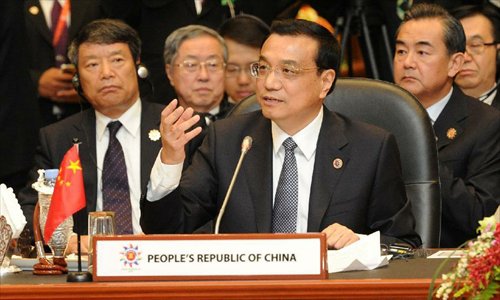SE Asia tests China's diplomatic creativity

Chinese Premier Li Keqiang (front) attends the 16th China-ASEAN leaders' meeting in Bandar Seri Begawan, Brunei, Oct. 9, 2013. (Xinhua/Liu Jiansheng)
Chinese Premier Li Keqiang kicked off his visit to Brunei yesterday to attend a series of meetings of the Association of Southeast Asian Nations (ASEAN) and the eighth East Asia summit. Premier Li's trip to the region immediately after President Xi Jinping's means visits or mutual visits between China and Southeast Asian nations except the Philippines have been held since the beginning of this year. The absence of US President Barack Obama from two summits in Southeast Asia because of the White House shutdown further projected China's position.
Obama once commented that China might be pleased to see his absence but the Chinese are not as naïve as Americans imagine. One absence does not mean an end to the US "pivot to Asia" strategy, and as a result the Chinese government has made thorough preparations to keep in "complicated touch" with the US in East Asia.
Both Beijing and Washington are supposed to accept each other's powerful presence in Southeast Asia. Thanks to its geopolitical influence in this region, China possesses certain advantages that the White House is envious of. Consequently, China has surpassed the US and become the largest trading partner of ASEAN.
However, the US "pivot to Asia" policy is a response to some concerns about China's rise in Southeast Asian countries whose assumption of the role in balancing the unprecedentedly rising power conforms to geopolitical rules.
What is important is that we should strive to maintain the relaxed atmosphere of the power game. China is committed to peaceful development and Chinese authorities are even reluctant to use phrases like "peaceful rise." Therefore, the two great powers should take time to address various thorny issues and concerns instead of urgently trying to determine the nature of each other's actions.
ASEAN has served as a top priority in China's diplomacy and played a dominant role in Asia's political architecture for a long time. Beijing's encouragement and assistance allows the association to give the fullest play to its role in Asia in the current stage, which would be impossible if China implemented "hegemonic" policies.
Despite its island disputes with several ASEAN countries in the South China Sea, the Chinese government, with its self-evident power, has never seen confrontation as a major solution, but has always been stressing cooperation. Relevant claimants to islands in the South China Sea should also keep a low profile. Long-term peace and stability in this region will be foreseeable in the near future if they bear the larger picture in mind and take a rational attitude.
At the geopolitical forefront of China, Southeast Asia has a critical stake in the rising nation. Nevertheless, it also serves as a barrier in the wake of numerous historical disputes and current frictions. Keeping benign relations with countries in this area is a test for China's strategic building capacity and diplomatic efforts.
Beijing has to resort to innovative ways in its foreign policy to safeguard its sovereignty in the South China Sea while avoiding becoming an enemy of the region.